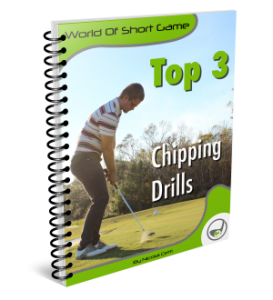- +4527976587
- mail@worldofshortgame.com

Chipping Downswing Tips: Achieving a Smooth and Controlled Follow-Through

Chipping Downswing Tips: Achieving a Smooth and Controlled Follow-Through
Chipping Downswing Tips: Achieving a Smooth and Controlled Follow-Through
Mastering the downswing and follow-through is crucial for consistent and accurate chip shots. While the setup and backswing set the stage, the downswing determines the shot’s trajectory, spin, and control. In this guide, we break down key chipping downswing tips to help you improve your short game.
Head Movement in the Downswing
A common misconception is that you should keep your head down throughout the swing. However, for an effective chip shot downswing, it’s essential that your head rises as you move through impact. This upward movement results from the body rotating and extending through the swing.
- Tip: Allow your head to move up and slightly forward as you transition into the downswing. This motion helps maintain structure in the left arm, preventing it from collapsing early. If your head stays too low, the left arm tends to buckle, compromising the shot’s consistency.
Back Heel Lift for Proper Weight Transfer
As you swing through, your back heel should naturally lift off the ground. This slight heel lift is a result of proper body rotation and weight transfer toward the front foot. If your heel remains firmly planted, it likely indicates that you’re not rotating your body enough, which can lead to poor contact.
Looking to improve your short game? I'm currently offering online lessons through the Skillest app with a 50% discount on your first lesson for all readers of the World of Short Game blog. Simply use the promo code "WOSG50percent" when booking your first session to get started at a discounted rate. Let’s work on your game together! ⛳️
- Tip: Check your heel position after hitting a chip shot. If it’s slightly lifted, you’re on the right track. This movement helps ensure weight transfer and promotes a smooth, controlled follow-through.
Clubface Rotation During the Downswing
The way the clubface rotates through the downswing directly affects shot direction, height, and spin. Ideally, the clubface should remain slightly open (pointing outward) through the follow-through, which allows for better use of the club’s bounce and prevents digging into the ground.
- Avoid Closing the Clubface: A closed clubface points down toward the ground, which can lead to low, left shots and make it harder to utilize the bounce. This can cause the club to dig into the turf, resulting in poor contact.
- Tip: Focus on keeping the clubface open during the swing. Avoid closing it too much, which restricts the club’s bounce and can lead to inconsistent results.
Releasing the Club
Whether or not to release the club in the downswing depends on the shot trajectory you’re aiming for and your preferred wrist action. The “release” refers to allowing the club’s angle to change as it approaches impact. If you prefer using your wrists in the backswing, you naturally create some space for a slight release during the downswing.
- Body-Only Swing: If you prefer moving the club primarily with body rotation and minimal wrist action, you will not have much of a release in the downswing. This lack of release can hinder your ability to control the shot effectively.
- Wrist Hinge: Conversely, if you incorporate some wrist hinge in the backswing, you can release the club slightly in the downswing, supported by body rotation. This method tends to produce a mid-trajectory chip shot.
- Tip: Experiment with wrist movement in the backswing to see how it affects your ability to release the club in the downswing. Finding the right balance will allow for smoother contact and better shot control.
Grip Pressure for a Smooth Downswing
Your grip pressure plays a significant role in the quality of your chip shots. Holding the club too tightly can lead to a rigid swing and poor control. A lighter grip encourages a smoother motion, promoting a more natural swing path.
- Experiment: Hit three different shots with varying grip pressures:
- Hold the club very tightly and hit a shot.
- Hold the club extremely lightly, almost letting go.
- Find a middle ground that feels comfortable and controlled.
- Tip: While grip pressure is a personal preference, the general rule is to avoid squeezing the club too tightly. A lighter grip usually allows for a smoother release and better control during the downswing.
Hands Moving Upward in the Downswing
A critical aspect of the downswing is the upward movement of your hands as they approach impact. Many golfers struggle with chipping because they push their hands downward during the downswing, causing the clubhead to dig into the ground. In contrast, skilled players move their hands upward before contact, creating a smoother interaction with the turf.
- Drill: Place the clubhead behind the ball and drag it along the ground slightly, feeling your hands naturally move upward. Practice this motion to get a sense of how your hands should move during the downswing.
- Tip: A helpful exercise is to purposely try to push your hands downward and observe the shot’s outcome. Then, switch to moving your hands upward and compare the results. The correct upward hand motion, combined with body rotation and extension, provides a greater margin for error.
Single-Arm Drill for Improved Follow-Through
Hitting chip shots with only your lead arm (left arm for right-handed players) can help you feel the correct body movement and hand position during the downswing and follow-through. This drill reinforces proper extension and prevents the arm from collapsing.
- Common Mistake: Many players struggle with this drill at first, often letting their left arm collapse without using body rotation. However, with practice, your body will naturally learn to turn and extend through the shot, making the hands move upward as they should.
- Tip: Keep your trailing arm (right arm for right-handed players) resting on your side during this drill for stability. Focus on maintaining connection with your body and moving the club with the left arm and body rotation.
Key Takeaways for a Consistent Downswing and Follow-Through
- Head Movement: Allow your head to rise during the downswing to maintain arm structure.
- Back Heel Lift: Ensure your back heel lifts off the ground for proper weight transfer and rotation.
- Clubface: Keep the clubface slightly open during the downswing to utilize the club’s bounce effectively.
- Release: Determine your wrist action preference and adjust the release accordingly.
- Grip Pressure: Use a lighter grip for a smoother, controlled swing.
- Hands Upward: Practice moving your hands upward in the downswing to avoid digging the club into the ground.
- Single-Arm Drill: Practice with your lead arm only to learn proper follow-through motion.
By applying these “chipping downswing tips,” you’ll develop a more consistent and reliable short game, leading to better chip shots and improved performance around the greens. Happy chipping!
Looking to improve your short game? I'm currently offering online lessons through the Skillest app with a 50% discount on your first lesson for all readers of the World of Short Game blog. Simply use the promo code "WOSG50percent" when booking your first session to get started at a discounted rate. Let’s work on your game together! ⛳️
You must be logged in to post a comment.



